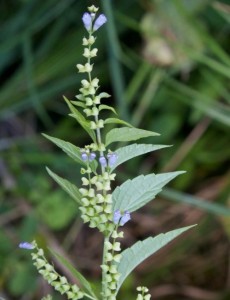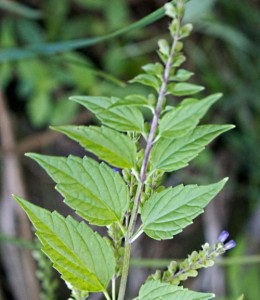Blue Scullcap(TRUE) – Scutellaria lateriflora
|
Current Demand = Normal |
Parts Used: Herb |
 |
 |
Family: Lamiaceae
Common names: mad dog skullcap, helmet flower, hood wort, hooded willow herb, Quakers bonnet, mad dog weed…
Description
This is a hardy perennial with branching stems of oval to triangular leaves and tubular, blue summer flowers from July to September that are only on one side of the flower stalk. The plant spreads through slender stolons and can fill an area rather quickly. This native perennial plant is 1–2½’ tall, branching occasionally. The stems are light green to pale reddish-green, 4-angled, and hairless or sparsely canescent; they have a tendency to sprawl. Scutellaria Lateralfora is native to North America and can be found east of the Rocky Mountains in the temperate zones. It is widely distributed in woods, moist thickets, marshes, and on the banks of streams. It is an herbaceous perennial that grows to a mature height of twenty-four to thirty inches.
Planting
Growing region: Blue Scullcap can be found thru-out the United States though larger populations are found to the west in Oklahoma, Missouri, Texas, Kansas and the Dakotas.
Although seed is commercially available, site selection is difficult. Skullcap requires areas of constant moisture, such as moist thickets or marshlands, to grow. It prefers a fertile soil, is hardy to zone four, and grows well in full sun or partial shade. When growing in a hot, dry area, shade and moisture must be provided. Once harvesting begins, fertilize with high nitrogen compost.
Skullcap can be grown through direct seeding, transplanting, or dividing the roots. The preferred method is to start seeds indoors. Skullcap seed requires a cold stratification period and light to germinate. Sow seeds shallowly in flats with a prepared soil mix. Moisten and refrigerate at 40-500F for seven days. Flats can also be placed outside where the seeds will be exposed to nighttime cold temperatures. After the required stratification period, put flats in the greenhouse for germination. Seeds should be started six to eight weeks before setting out in the field. In late spring, transplant outside in well-prepared soil. Space plants eight to twelve inches apart in rows one and one-half to three feet apart or in three-foot wide beds. Once established, plants will spread quickly to fill the bed. It is very important to keep the beds and rows weeded.
Direct seeding can be done outside in spring. In a well-prepared planting bed, shallowly sow one to two seeds per inch using the recommended row spacing. When plants have several sets of true leaves they need to be thinned and when placed allow eight to twelve inches apart. Once plants are established, root divisions can be made in spring or late fall.
Harvesting/Drying
Parts used: herb
It is the aerial part of the plant that is harvested and used for medicinal purposes
For maximum potency, Blue Scullcap should be harvested during the summer months while the plant is in bloom. Cut the plant off at ground level to allow the root system to stay in tact for future growth. Gather the larger more mature plants leaving plenty of younger smaller plants to seed the area for future harvest. For drying purposes and to preserve the green color gather Scullcap in the afternoon after the morning dew has dried. Once flowering begins the plant is cut with shears or a mower. A light cutting the first year is possible, followed by two cuttings each consecutive year. When harvesting skullcap, keep the freshly cut herb in the shade until harvesting is complete or take immediately to the drying area. Do not allow the plant material to heat up.
After harvest, remove all foreign matter (rocks, weeds and vines) and spread in a thin layer immediately. Scullcap can be dried outdoors though it needs to dry out of the sun. At night cover the Scullcap to keep the dew from setting on the drying herb. When possible dry indoors in a well ventilated barn loft or attic to protect against the elements. If natural heat is not available, you may need to add heat and a fan for continuous airflow. Whether you dry indoors or outdoors you will need to turn the herb daily.
The key to drying any root, herb or bark in an even combination of heat and airflow. Never use an oven or microwave.
The Scullcap will be completely dry (largest stem will snap not bend and leaves will crumble) in 3-7 days depending on the drying conditions. Place the herb carefully into a cardboard box or paper bag for storage in a dry area until you are ready to sell or use. Do not store the herb in plastic or it will mold.
 Root Buyer
Root Buyer